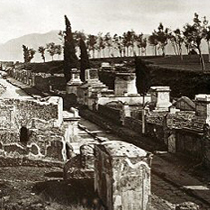 1>
1>Approaching Pompeii the street of Tombs
Whilst the fortifications did not appear in the wall-paintings, another very visible part of the experience of approaching the city was depicted. Before entering Pompeii travellers were subjected to a lesson in ancestral lineage and memorialisation. It was provided by the many tombs and commemorative edifices that lined the approach roads (fig.1) They offered the weary traveller a shaded place to rest and contemplate the many epigraphic inscriptions that commemorated the achievements of the city’s distinguished citizens. For those living in Pompeii these edifices acted as poignant reminders of departed ancestors, as well as a places to perform libations and hold celebratory ritual banquets. (For more on this subject see J. M. C. Toynbee, 1971, Death and burial in the Roman world, London.) Vignettes depicting similar monument lined streets are amongst the very few local features to appear in the wall-paintings and it is by no means certain that the images reproduced are local as opposed to generic (fig.2).
62 AD Earthquake
The volcanic eruption that fixed Pompeii and Herculaneum in the year 79 AD, also suspended the various historical layers that made up the city’s history until that date. At the time of the eruption parts of Pompeii were still being repaired following a severe earthquake that occurred 17 years earlier in 62 AD. The selective nature of the reconstruction programme, in addition to the erection of new buildings, provides us with an indication of the community’s priorities at the time. [The economic and social effects of the earthquake are discussed by Jean Andreau in ‘Histoires des séismes et histoire économique. Le tremblement de terre de Pompéi (62 ap. J.C.),’ AnnalesESC 28 (1973), pp.369-95] These appear to have focused on the renewal of private dwellings, non-state controlled places of worship, such as the Temple of Isis, and business premises. Work also seems to have begun on a new public bath, in preference to the reconstruction of earthquake damage elsewhere, notably in the area of the civic forum. The condition of this area and its public buildings, as seen today, may owe more to damage caused by the earthquake, than that of the eruption. The fact that sites associated with governance and state remained unreconstructed may well be indicative of public and private attitudes prevalent at the time, which appear to have focused on the domus and its wellbeing during the brief period of calm that followed the earthquake.
The restoration of earthquake damaged paintings, as well as complete over painting during this period, emphasises the fact that during the lifetime of a domus wall-paintings were commissioned by different generations and possibly even different owners. This may seem an obvious observation, but its ramifications are significant because of the remarkably consistent conceptual trajectory demonstrated by the wall-paintings, and not just within a single house but from house to house. So much so that it enabled August Mau to broadly classify Roman painting into four ‘Styles’ (figs.3-6).
|